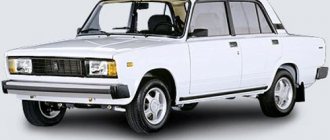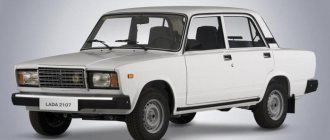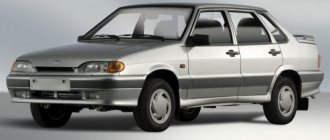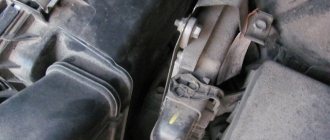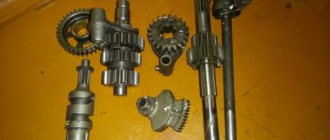The production of frets of this model began in 1997; they belong to the popular Samara family. Thanks to the technical advantages of the car and the rigor of its design, it has become very popular on the market. Experts also include the fuel consumption of the VAZ 2115 as an advantage.
These reliable cars were produced in large quantities from the factory, and their supply stopped only in 2012 after the appearance of the new Granta model. Many car enthusiasts were never able to say goodbye to the previous modification of the car, so they still continue to use the VAZ with pleasure.
| Engine | Consumption (highway) | Consumption (city) | Consumption (mixed cycle) |
| 1.6 l | 6.3 l/100 km | 10 l/100 km | 7.6 l/100 km |
Specifications
This is an improved model of the well-known VAZ 21099. The sedan that replaced it has become more popular than its predecessor. It features a number of positive innovations, which include a more modern assembly, economy, and the necessary comfort for the driver.
In Samara, the front optics have been modernized, the design has become streamlined and modern, and the stylish updated trunk lid attracts the attention of many consumers. The modified sedan can be equipped with electric windows, fog lights or heated seats. The on-board computer has become a classic feature for this car.
Engine 1.3
The modification with the 1.3 engine has been produced since 1997 in limited editions. This is a structurally complex power unit with a rotary cylinder arrangement configured for maximum efficiency, producing 135 forces. With it, the car accelerates to hundreds in 9 seconds and a top speed of 190 kilometers per hour. The fuel consumption of the VAZ 2115 in this configuration is:
- in the city 12.5 l;
- in mixed mode 10 l;
- on the highway 7.5 liters.
It will be useful: Tuning Lada Granta sedan: photo and video review
Owner reviews
- Alexander, Vyborg. My brother gave me his 2003 VAZ 2115 with a 1.3 engine with 135 horsepower. Pleasantly smooth ride, starts off very quickly, although you need to strictly monitor the engine. The fuel consumption is confusing compared to other versions; all around it’s about 12 liters per hundred, which is more than the classic. But speed comes at a price.
- Denis, Saratov. I bought 2115 in 2009, used, with a mileage of 150 thousand km. The car drives very well, to make it more comfortable, I installed an air conditioner, but gasoline consumption has become frightening - in the city in the heat it turns out to be up to 13 liters, I fill it with AI 92.
- Alexey, Kotelnikovo. I have a VAZ 2115 produced in 2002 in an interesting modification with a 1.3 engine with 135 horsepower. My opinion is that the car has an ill-conceived gearbox, and therefore cannot reveal its full potential. With good dynamics, consumption is 14 liters, I’m thinking of changing it to something more economical.
Advantages of the machine
For more than ten years, developers of modern cars have been resorting to a new type of fuel supply. Outdated carburetors have been replaced by injectors that increase engine efficiency. At the same time, they significantly reduce the flow of fuel into the tank, which significantly saves fuel consumption.
VAZ has such capabilities, which positions itself as a reliable, economical sedan modification vehicle. The fuel consumption of the VAZ 15 per 100 km is significantly less than that of other cars of a similar pricing policy.
Engine 21124 (16 valves, 1.6 mt 90 hp)
Starting from 2009, 16-valve engines began to be installed in the “four”. The first variation with a gearbox from Super-Auto was released in 2009. From this moment on, the model received a second life, because more technologically advanced and dynamic engines combined with the lightweight body of the “fourteenth” went well together. At the same time, the fuel consumption on the 124th engine has changed slightly:
- City mode on the 124 engine “eats” 8.2 liters per hundred kilometers of road. Compared to earlier 8-valve engines, the “gluttony” indicator has decreased by almost two liters of fuel;
- When driving on the highway, the figure is about 7.2 liters, but according to the plant. In practice, this figure varies from 5.8 to 8;
- Average mode – 7.6-7.8.
Car fuel consumption standards
Official data
Gasoline consumption indicators according to technical data sheet
:
- The fuel consumption rate for a VAZ 2115 (injector) on the highway will be 6 liters.
- In the city, the consumption indicator will indicate 10.4 liters.
- In areas with mixed roads – 7.6 liters.
Real gasoline consumption data
The average fuel consumption of a VAZ 21150 with a manual transmission, engine capacity of 1.6 liters is 7.25 liters on the highway, in the city this figure increases to 10.12 liters, and in mixed mode - 8.63.
Flow data in cold weather
:
- Gasoline consumption in winter on a Lada 2115 will be up to 8 liters on the highway.
- Within the city limits you will have to spend 10.3 liters.
- The mixed view of the road will show the fuel consumption of a 9 liter VAZ.
- Off-road in winter, the car will consume 12 liters.
Actual gasoline consumption of VAZ in summer
:
- In summer, on the highway you will need 6.5 liters with a mileage of 100 km.
- The fuel consumption of the car in the urban cycle is 9.9 liters.
- With a mixed route, fuel consumption will correspond to 8.3 liters.
- In off-road conditions, VAZ 2115 gasoline consumption per 100 km increases to 10.8 liters.
These are good data that determine the economy of a domestically produced car and show its advantage over some foreign cars.
Table of fuel costs for VAZ brands.
The table describes the average costs for different VAZ brands . Fuel consumption is presented in three types - city, highway and mixed (average) fuel consumption. All data on fuel costs are from the VAZ car manufacturer. For almost all brands of VAZ cars, fuel consumption does not exceed 10 liters per 100 km, with the exception of the carburetor Niva.
Average fuel consumption VAZ
VAZ has acceptable fuel consumption!
The car is given good dynamics and acceptable fuel consumption thanks to its reliable engine. VAZ has an affordable price for both a new and an old car. Old VAZ brands are acceptable to most people. The new VAZ engine demonstrates extreme efficiency, thanks to which the car has low fuel consumption and a reduced level of harmful emissions into the atmosphere.
VAZ - average quality cars, affordable price and acceptable fuel consumption.
What could cause increased consumption at VAZ?
1. Increased VAZ fuel consumption is observed in cars with a worn out engine. High piston wear will increase fuel consumption of any VAZ brand. Wear is determined by measuring compression in the VAZ engine block. If the compression is low, the piston needs to be replaced (rings, piston, block boring).
2. The increased flow rate is influenced by the coolant temperature, throttle position, mass air flow and detonation sensors.
3. High fuel consumption in VAZ cars is observed when the accelerator drive is faulty, the wheel alignment is adjusted correctly, or tire pressure is reduced.
4. An increase in fuel consumption in VAZ cars with carburetor engines is observed when there is a problem with the carburetor. These are holes in the diaphragms, incorrect adjustment of the choke cable, enlarged fuel jets, mixing up of air jets in two working chambers (chamber 1 = 165 mm, chamber 2 = 125 mm).
Timely completion of technical inspection will allow VAZ to maintain fuel consumption at the level declared by the manufacturer.
Causes of excessive fuel consumption in Lads
Over time, each vehicle can increase its fuel consumption, which can be due to various factors. The main reason is engine wear or clogged spark plugs. Proper care of your vehicle will bring you pleasure from high-quality, safe and economical driving for many years.
It is necessary to strictly monitor the fuel injectors, fuel pump and fuel filter, which primarily suffer during long-term operation and lead to high fuel consumption.
The average fuel consumption at idle for the VAZ 2115 per 100 km is 6.5 liters. This figure may decrease or increase depending on the modification of the car and the year of manufacture. The rate of gasoline consumption at idle speed and electronics turned off is 0.8-1 liter per hour.
According to the passport, the fuel consumption of the VAZ Samara-2 car is 7.6 liters in mixed mode, in the city - no more than 9. If such indicators have increased, then the car owner needs to determine the cause and eliminate it.
Speed sensor
Also, the cause of high fuel consumption per 100 km (VAZ-2114) may be the speed sensor. Its main task is to transmit information about the speed of the vehicle to the control unit. The latter monitors the operation of the engine by adjusting the throttle valve. The problem with this sensor will be shown by the on-board computer or error reading device. It is almost impossible to replace it yourself without specialized knowledge. Typical symptoms of speed sensor failure:
- Speedometer failure or interruptions.
- “Floating” idle speed.
- Noticeable loss of traction.
- Stopping the engine when idling.
- Increased gasoline consumption.
Bottom line
A car with an injector and built-in computer technology can easily be tuned, which gives it a more modern look, aesthetic beauty, and more comfortable operation. The above indicators of gasoline costs according to real data and according to the technical data sheet do not have significant differences
. It all depends on the care of the car, parking location, and weather conditions.
Despite the fact that the production of this car has already ended, you can see many happy VAZ owners on the roads, which indicates its reliability, high wear resistance, economy in maintenance and fuel consumption. The plant in Togliatti, where the car was produced, has been famous for many years for the high quality of the vehicles produced, which are optimally suited to the conditions of use in our region.
VAZ-2115 owner reviews
With a 1.5 engine 76-78 liters. With. petrol manual transmission
- Yuri, Lipetsk. VAZ-2115 produced in 2012, a car from the last batch. We took it to our editorial office for testing. Everyone already knows about the car, the car has been thoroughly studied. But tag is a whole era, and we had to carry it out properly. For this purpose, they organized a resource test. The sedan drove 100 thousand km and showed itself to be a great guy. Average consumption is 8-9 liters with a 1.5 engine. The gearbox is still alive and works great. Overall, a reliable car for the money, but it still requires timely maintenance.
- Marina, St. Petersburg. A car for all occasions, ideal for both the city and country roads. Moreover, my fifteenth has high ground clearance, which allows it to be used off-road. The lively 1.5-liter engine consumes 10 liters/100 km.
- Denis, Magnitogorsk. I liked the car. In my opinion, much better than the Chinese cars of the early years. At least our brand behaves more honestly and predictably or something. In addition, the service center has all the spare parts. Fuel consumption 10 liters.
- Konstantin, Togliatti. My VAZ-2115 was bought by my father, then it was inherited, so to speak. The car was produced in 2003, with a mileage of 193 thousand km. Still running, no complaints yet. Consumption 9-11 liters.
- Nikolay, Kharkov. A worthy car of its time, a whole era for our AvtoVAZ. It's right that it was removed from the production line. Better late than never. And I sold mine just in 2012, when it was removed. The car of my youth consumed no more than 10 liters of 92 gasoline.
- Alexey, Moscow. A good car, simple and easy to use. Very cheap to maintain, the design of the machine couldn’t be simpler. The cabin is very comfortable, if you don’t pick too much. All controls are at hand. The 1.5-liter engine is very economical in the city, consuming an average of 9 liters per hundred. 78 horses allow you to reach the first hundred in 14 seconds, and I think this is acceptable for the money.
- Nikita, Nikolaev. I'm happy with the car, this is my first car. I bought it in 2013, it was just then discontinued. It's called successful. Equipped with a 1.5-liter gasoline engine, front-wheel drive and manual transmission. Everything is the old fashioned way. Everything works properly, I take care of the car regularly. Fuel consumption 10 liters.
- Boris, Sverdlovsk. An excellent car for a beginner, a very easy to learn car. Eats no less than 10 liters of gasoline. The 1.5-liter 75-horsepower engine drives like a 100-horsepower one. Maybe it seems so because of vibrations and aerodynamic noise, although the engine is actually quite peppy for such a displacement.
- Nikolay, Donetsk. A normal car for the money. I have a used one with 100,000 miles, but so far everything is working fine. Gasoline consumption with a 1.5 engine is 10 liters/100 km.
- Larisa, Kaliningrad. The car is from 2008. I praise the tag for its lively and dynamic engine, which behaves like a fighter throughout the entire rev range. VAZ people know how to make engines. Consumption 9-10 liters.
With engine 1.6 80 l. With. petrol manual transmission
- Alexey, Stavropol region. The car was given to me for my birthday. In maintained and good condition. I restored some small things, now I drive and am happy. I’ve been friends with the spotty for half a year now; my 1.6-liter car consumes 9 liters of gasoline.
- Konstantin, Peter. A compact car for every day. The rear cabin is cramped, but the car rides smoothly, and for our roads this is more important than royal space. Consumption is 8-10 liters per hundred km.
- Daniil, Moscow. The car was produced in 2005, with a mileage of 220 thousand km. My little car has been in all sorts of troubles, even kneading mud and at the same time not choking thanks to its high ground clearance. In general, the car is great in terms of cross-country ability. Front-wheel drive is enough for her. In addition, the car has narrow tires, which is a plus for off-road use. My sedan is equipped with a 1.6-liter 80-horsepower engine and a manual transmission. Everything is as it should be, the old fashioned way, let’s say. The average gasoline consumption per 100 km is 10-11 liters.
- Yuri, Novosibirsk. I like the car. I've had it since 2009, and I still don't drive it for us. I just love its 1980s style design. Quite a comfortable car for the money, and it’s a pity that it is no longer produced. At least they could release the next generation, because such cars are not forgotten. My car consumes 10 liters with a 1.6 engine.
- Vladimir, Krasnoyarsk. The car is from 2003 and is still in my garage and running. I serve it myself. A simple and durable design, there is essentially nothing to break. In general, everything would be perfect if there were high-quality spare parts. It turns out that all these minor problems arise due to cheap parts. Well, it’s okay, I won’t have to be bored with the tag for at least another two years. I think by then I’ll be building a Volkswagen Polo. The car consumes an average of 10 liters/100 km.
- Oleg, Arkhangelsk. The car is comfortable and dynamic, acceleration to the first hundred in 13 seconds, nothing like that. The car is equipped with a 1.6-liter internal combustion engine with a power of 80 horsepower, which is enough for the eyes. Consumption 10 liters.
- Dmitry, Petrozavodsk. VAZ-2115 is a tribute to history in the Russian automotive industry. But I think its production should have been completed back in the days of the VAZ-21099. There was no point in upgrading to a tag; the car remained essentially unchanged anyway. But many people like it, because they still buy it on the secondary market. My car is a 1997 model, I bought it new from the factory. I will say objectively that the car was worth the money that was asked for it back then. Consumption is 9-10 liters per hundred.
- Dmitry, Penza. I bought a spotty from a friend, he had just collected one for his Renault Logan. A car with a 1.6 engine drives well and brakes well on dry asphalt. A simple and easy-to-maintain car for me, a handy guy. The engine consumes no more than 10 liters.
- Mikhail, Tver. My car is 2010, I have already put 400 thousand miles on it. I drive a lot on the highway, that's why the consumption is so high. I work in a taxi, I mainly do out-of-town transportation. Before a long journey, I always check the trunk to make sure there is a set of pelvis pipes in there. On the highway the car eats 7-8 liters. Yana, Nikolaev. I like the car, it's simple and easy to drive. Gasoline consumption with a 1.6 engine is 8-10 liters/100 km.
Sources
- avtomera.com/vaz/vaz-2115-rasxod-topliva-na-100-km-dvigatel-1-5-1-6-8-klapannyj/
- drive2.ru/l/1407268/
- rasxodtopliva.ru/92-vaz-2115.html
- drom.ru
